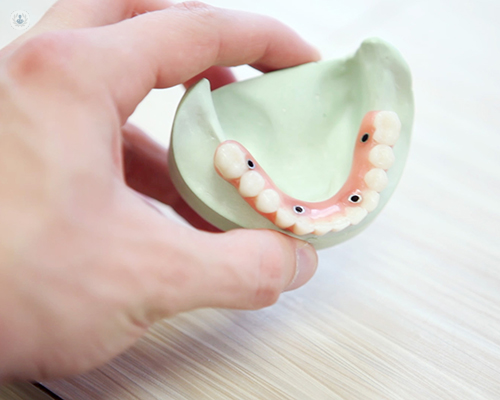What are my chances of developing peri-implantitis if I have dental implants?
Escrito por:Peri-implantitis is an inflammation of the soft tissues around a dental implant, leading to bone loss. It's a common condition, affecting between 5 to 50 per cent of people who have dental implants, but with the right strategies, it can be prevented. We asked implant and restorative dental surgeon, Dr Koray Feran, for tips on what you can do.

Are there types of dental implant that are more prone to peri-implantitis?
There are several factors:
Implants with very rough surfaces can be more prone to peri-implantitis, However, the factors that cause this rough surface to be exposed to the bacteria of the mouth, rather than the bone, is arguably of more significance than the implant surface as such.
Incorrect implant placement position with too little investing bone or too thin a layer of gum over the implant are risk factors. Correctly planned implant placement is important. Bone and gum augmentation to thicken the layer of bone and gum around implants is often required, and can reduce the risk of future tissue recession and exposure of the implant over time. Sometimes, these might be omitted to keep costs down or if the implant surgeon is not experienced at bone and tissue augmentation. But thicker tissues around the implant are associated with better aesthetics and more stable peri-implant gum health over time.
Poor oral hygiene and a history of tooth loss due to gum disease (periodontitis) are definite risk factors. The patient’s own genetics play a role.
Design of the crown, bridge or prosthesis on the implant(s) can prevent good hygiene. Access for cleaning by the patient is very important. The material and manufacturing process of the intervening abutment that holds the crown or bridge to the implant are important. Titanium and zirconia are good materials for gum health. Gold, glazed porcelain and non-precious alloys, such as cobalt chrome as well as any contaminated surface, are not as they do not allow the best gum seal long term and allow bacteria under the gum.
Excess cement left around crowns cemented onto implants can also cause problems where bone can be rapidly lost due to inflammation or infection (so called peri-implant cementitis).
Sometimes, more than one of these factors will tip the balance and it is therefore important to control all of these for the best success and prevention of future disease.
What are the warning signs of peri-implantitis?
Much the same as gum disease:
- Bleeding when brushing
- The tissues around the implant looking swollen and dark red rather than tight and pink
- A discharge being apparent at gum level when the gum tissues over the implant are pressed
- Bad taste
- Recession of tissues exposing the implant surface
On X-ray, bone loss is seen around the implant as the disease progresses. It rarely causes pain or much discomfort, so can be neglected.
How often should I see the dentist to ensure my dental implants are healthy?
I routinely recommend at least quarterly visits so that your dental hygienist and therapist can see you every three months. The early signs can then be detected and preventive measures advised.
In severe cases, I may even see patients every six weeks.
Are there are any cleaning tips to ensure your dental implants remain clean and free from the risk of peri-implantitis?
Thorough but gentle physical cleaning around the implant is vital. Your hygienist can show you the most appropriate hygiene aids for your particular design of implant crown or prosthesis.
As well as brushing, patients can use bottle brushes, floss, crown and bridge floss which is thicker and collects more debris under the gum. However, it is important not to traumatise the tissues while attempting to clean, and professional advice on cleaning is a vital part of the patient’s implant journey.
LEARN MORE: DENTAL IMPLANTS – WHAT ARE MY OPTIONS?
If peri-implantitis is detected, how will it be treated?
It depends on how advanced it is.
Early peri-implant inflammation (known as peri-implant mucositis where bone loss has not started yet) can resolve easily like gingivitis around teeth. Professional cleaning and better home cleaning around the implant will allow the gum tissues will go back to normal.
However, peri-implantitis involves loss of bone and exposure of the implant surface, so it can only be definitively treated with localised surgery to clean the implant surface and restore the lost bone and gum tissue.
If the bone loss has extended to more than half the length of the implant, usually it is better to replace the implant with a new one. It should be remembered that the teeth that sit on the implant will also need to be replaced. However, every case is decided on its own merits and requires careful thought and a systematic approach to the problem.
In the worst cases, the implant will completely fail due to bone loss and become loose. This implant must be removed and the area allowed to heal prior to deciding on the ideal replacement. We obviously wish to prevent this, but in susceptible patients, this can be alarmingly rapid and needs rapid diagnosis and intervention as soon as possible.
If you're worried about symptoms of peri-implantitis, don't hesitate to book a consultation with Dr Koray Feran via his Top Doctors profile today.


